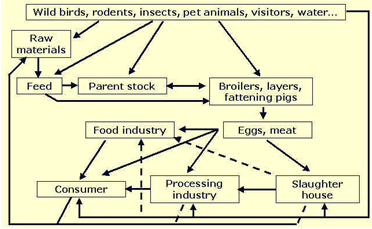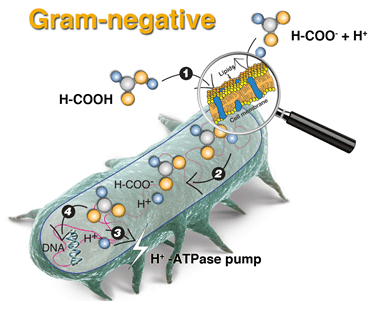



Control of Salmonella in Poultry Nutrition by Means of Organic Acids
Salmonella ranks among the world’s biggest threats to human health. In the United States alone, it is thought to be responsible for around 378 deaths and an estimated 19,336 hospitalisations each year, according to Sarah Mellor and Christian Lückstädt of ADDCON Europe GmbH. And those are just the reported cases.If you have ever had to take a few days off work with a nasty case of ‘food poisoning’, but not bothered the doctor to get it treated, there is a chance you have had a close encounter with this unpleasant little bug without becoming one of the statistics yourself. Salmonella ranks second on the food poisoning leader-board in the US, where it is the premier bacterial food-borne disease.
Countless cases of Salmonella-based food poisoning continue to occur and a very recent outbreak in the US was traced back to ground turkey meat. The fact that this contamination was found in meat from a major poultry integrator further emphasises the need for effective control measures from farm to fork.
Where do Salmonella Come from?
Salmonella is often associated with poultry products – chicken and eggs. However, it would be a mistake to assume that these are the only food sources that can transmit this disease. Birds are a major source, true; strains can also be transmitted through pork and processed pork products. Salmonella, however, has also been spread through salad vegetables and peanuts. If we can eat it, there is a good chance that this bacteria can live on it, or at least survive long enough to be carried into an animal (or person)’s digestive tract.
Salmonella’s health statistics also make for some sobering economic facts. In the US, for instance, the Center for Disease Control recently estimated a total annual cost of US$3 billion associated with Salmonella. Similar calculations from Denmark in 2001 took this further, suggesting that spending the equivalent of US$14.1 million, implementing a Salmonella control programme actually resulted in a net saving of US$25.5 million to the national economy.
In all these ways and many others, Salmonella is a pernicious pathogen and eradicating it entirely from the food chain is difficult. Despite our best efforts to eradicate it from the food chain, it continues to cause expensive and devastating losses of both livestock productivity and human life.
Antibiotic Resistance from Farm to Fork
Antibiotics had long been used to prevent Salmonella infections in animal production. However, alarming news in this respect recently emerged in a report from the Federal Institute for Risk Assessment in the European Union. Taking all strains of Salmonella into account, it found that 40 per cent of them are already multi–drug resistant (Table 1). A more recent report stated: “The proportion of Salmonella and E. coli isolates resistant to ampicillin, sulfonamides and tetracycline varied between five per cent and 68 per cent in poultry, pigs and cattle. Some Member States reported a high occurrence of fluoroquinolone resistance in Salmonella isolates from poultry (five per cent to 38 per cent).”
Ironically, the EU is one of the regions in the world with exceptionally stringent Salmonella surveillance and control systems. This implies that antibiotic resistance in Salmonella and the other pathogenic bacteria can happen everywhere!
| Table 1. Resistance of Salmonella isolates in Germany | |||
| Number of Salmonella isolates | Number of anti-microbial agents | Level of resistance (%) | Level of multi-resistance (%) |
|---|---|---|---|
| 11,911 | 17 | 63 | 40 |
It is now clear that we have been arming our enemies for decades. Multiple antibiotic resistances in pathogenic bacteria are becoming a serious health issue. If antibiotic resistance is transmitted to more common food–borne pathogens like Salmonella and Campylobacter, resistance could become a major problem, especially in vulnerable groups of people. When a patient develops a disease caused by one of these resistant bugs, the first antibiotic used against it might not be the one that works, giving the bacteria more time to cause more damage.
Many countries have already banned the non–therapeutic use of antibiotics in livestock, including broilers and laying hens. For such control systems to be effective, every step of the food chain, from feed raw materials to home preparation has to be scrutinised. At this time, integrated food chain tracing systems for Salmonella are already in force in most countries.
For example, in the poultry production chain’s layer and broiler lines, there are many points in which intervention may be successful. All inputs into poultry production (including vermin, water, feed, visitors and new stock) need to be protected (Figure 1).

(Adapted from Oostenbach, 2004)
Next to hygiene and management interventions, the control of Salmonella via dietary means has become very popular. For decades, antibiotics served this purpose but their use is in decline due to emerging bacterial resistance. As a result, alternative dietary strategies have attracted much attention. It is well accepted that feed hygiene is successful in preventing accidental Salmonella contamination in the poultry house from developing into a food contamination problem. Naturally, feed producers are attracted by alternative feed-based control strategies. Progressive research shows that feed additives, among them organic acids and their salts, are both reliable and safe defences against pathogenic infections in livestock.
Organic Acids – a Sustainable Option
Organic acids have long been used to counteract gram–negative pathogenic bacteria in animal feed, mainly in pig production. This approach is currently being further investigated for poultry nutrition – especially to combat Salmonella, in order to establish a healthy gut.
The potential of single organic acids in feed preservation lies in their ability to protect feed from microbial and fungal destruction. Their effects on stomach pH and gut flora have also been known for decades and proven in many laboratory and field trials (Eidelsburger et al., 1992; Eidelsburger and Kirchgessner, 1994; Freitag, 2007). Acidifiers act as performance promoters by lowering the pH in the gut (mainly upper intestinal tract), inhibiting the proliferation of unfavourable microorganisms. Gut acidification stimulates enzyme activity and thus optimises digestion and the absorption of nutrients and minerals. Un-dissociated forms of organic acids penetrate the lipid membrane of bacterial cells and dissociate into anions and protons. After entering the neutral pH of the cell’s cytoplasm, organic acids inhibit bacterial growth by interrupting oxidative phosphorylation and inhibiting adenosine triphosphate-inorganic phosphate interactions (Figure 2).

Since the 1980’s, reports have shown organic acids, and formic acid in particular, to be especially effective against Salmonella, when used in poultry diets. The use of pure formic acid in breeder diets reduced the contamination of tray liners and hatchery waste with S. enteritidis drastically (Humphrey and Lanning, 1988).
By 1990, researchers in the US found significantly reduced levels of Salmonella spp. in carcass and caecal samples, after including calcium formate in broiler diets (Izat et al., 1990). Further research (Kovarik and Lojda, 2000) reported that formic acid at 0.5 per cent in the diet can be successfully used at farms to reduce salmonella contamination in feed, excretion of Salmonella spp. and re-infection of chicken populations.
The scientific literature is full of such reports but in practice, a number of more practical issues will sort out the effective acidifiers from the rest. Pure formic acid, however effective in feed, is also corrosive, hazardous, as well as volatile – it is literally too difficult to handle in a feed mill.
Furthermore, while producing pelleted poultry feed, you can expect losses of up to 20 per cent of the formic acid being used. Furthermore, these volatile, liquid–based acids only offer antibacterial protection in the feed and the foregut of the birds.
Recent research has focused on overcoming these limitations. Chemical compounds which are heat-stable, non–corrosive and yet still effective are the way forward. Diformates, like sodium diformate (ADDCON) satisfy these industry requirements. Sodium diformate provides the anti-bacterial protection of formic acid while its crystalline, non–volatile nature allows it to be used safely in the feed mills. When used in animal feed, this enables the diformate to provide effective, efficient, yet safe protection against Salmonella and other antibiotic-resistant pathogens.
A trial with diformate (Lückstädt and Theobald, 2009), showed how a healthy gut – with lower amount of Enterobacter as well as Salmonella and Campylobacter, was achieved in broiler fed 0.6 per cent of sodium diformate (Table 2).
| Table 2. Results of microbiological investigation of the intestine (CFU/g) in broiler fed with or without sodium diformate (NDF) for 39 days | ||
| Control | NDF 0.6% | |
|---|---|---|
| Enterobacteria | 107 | 105 |
| Lactobacilli | 107 | 108 |
| Bifidobacteria | 105 | 106 |
These results clearly show the beneficial effects of NDF against pathogenic bacteria in broiler, while leading to a state of eubiosis in treated chickens. Notably lower Enterobacter numbers and distinctly higher Lactobacilli and Bifidobacteria numbers show the beneficial impact of NDF on the intestinal microbiota.
A recently published study by DEFRA (Department for Environment, Food and Rural Affairs, UK, 2012) analysed the effect of NDF against pathogens in poultry. The product was especially assessed for anti–Salmonella activity in the presence of different matrices, like crop contents and caecal contents. This involved addition of the diformate at 0.6 per cent followed by the addition of a defined number of colony forming units of the challenge strains (Salmonella enteritidis and S. typhimurium). After a certain period of incubation, a semi-quantitative sensitive isolation technique was applied to determine any change in cell count.
In crop contents there was a log 5 reduction in only one hour with no re-growth detected at four and nine hours. In caecal contents, there was a log 1 reduction at nine hours and a log 4 reduction at 24 hours (Table 3).
| Table 3. Anti-Salmonella effect of sodium diformate (NDF) in different matrices from the gastro–intestinal tract of poultry (in log-units) | |||
| Crop | Caecum | ||
|---|---|---|---|
| Hours after challenge | 1 | 9 | 24 |
| 0.6% NDF | -5 log CFU | -1 log CFU | -4 log CFU |
Conclusion – Combined Strategies
Using acidification in broiler diets is a valuable strategy in the producer’s armoury against productivity losses caused by pathogenic bacteria. Combined strategies that include biosecurity and a proper hygiene management along with the use of organic acid salts like diformate have a highly beneficial impact in reducing the incidence of Salmonella outbreaks in both humans and livestock.
The results described above prove irrefutably how healthy livestock guts, inhibited pathogen growth and food safety can be achieved by dietary means, without resorting to antibiotic supplementation. Together, these measures offer a sustainable, yet highly effective means of raising healthy, productive livestock while safeguarding human health.
March 2012








